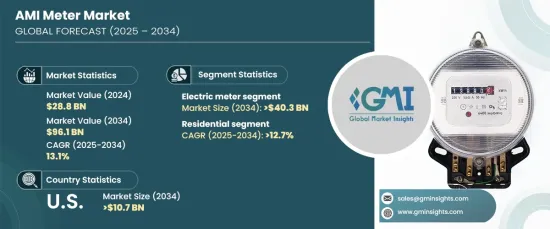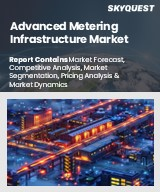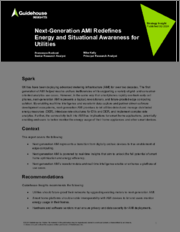
|
시장보고서
상품코드
1666588
AMI 미터 시장 기회, 성장 촉진요인, 산업 동향 분석, 예측(2025-2034년)AMI Meter Market Opportunity, Growth Drivers, Industry Trend Analysis, and Forecast 2025 - 2034 |
||||||
세계 AMI 미터 시장은 2024년 288억 달러로 평가되며 2025년부터 2034년까지 연평균 13.1%의 성장률을 기록할 것으로 예상됩니다.
이러한 성장의 원동력은 에너지 효율에 대한 강조, 스마트 그리드 시스템의 현대화, 첨단 유틸리티 관리 기법의 증가에 기인합니다. 각국 정부는 에너지 절약을 촉진하기 위해 강력한 정책 및 규제 프레임워크를 도입하고 있으며, 그 결과 스마트 그리드 인프라에 대한 막대한 투자가 이루어지고 있으며, AMI 미터는 실시간 데이터 수집, 원격 모니터링, 양방향 통신, 정확한 청구, 효과적인 수요측 관리, 재생에너지 원의 기존 그리드와의 원활한 통합을 가능하게 합니다. 재생에너지원을 기존 전력망에 원활하게 통합할 수 있습니다.

전 세계 에너지 환경이 변화함에 따라 AMI 미터는 지속가능한 솔루션에 대한 수요 증가에 대응하기 위해 전력회사에 필수적인 요소로 자리 잡았습니다. 이러한 장치는 에너지 낭비를 줄이고, 그리드 성능을 최적화하며, 소비자 참여를 강화하는 데 매우 중요하며, IoT, AI, 데이터 분석과 같은 첨단 기술의 통합은 시장에 혁명을 일으켜 예지보전, 정확한 부하 예측, 고급 에너지 분배 전략을 가능하게 하고 있습니다. 또한, 이산화탄소 감축 목표 달성과 재생에너지 자원의 효율성 향상을 위한 전 세계적인 움직임은 AMI 시스템의 채택을 확대하여 보다 친환경적인 미래로의 전환에 필수적인 요소로 작용하고 있습니다.
| 시장 범위 | |
|---|---|
| 시작 연도 | 2024년 |
| 예측 연도 | 2025-2034년 |
| 시작 금액 | 288억 달러 |
| 예상 금액 | 961억 달러 |
| CAGR | 13.1% |
전기 계량기 분야는 실시간 전력 소비량 모니터링에 대한 수요가 증가함에 따라 2034년까지 403억 달러 규모의 시장을 창출할 것으로 예상됩니다. 이러한 계량기는 사용자에게 에너지 사용을 최적화하고 비용을 절감할 수 있는 권한을 부여하여 유틸리티 비용을 효율적으로 관리하고자 하는 주택 소비자들 사이에서 큰 매력을 창출하고 있습니다. 스마트 미터의 채택은 에너지 효율을 촉진하기 위한 인센티브, 보조금 및 의무를 제공하는 정부의 노력에 의해 더욱 가속화되고 있습니다. 이러한 채택의 급증은 스마트 미터가 장기적인 에너지 절감을 달성하기 위한 비용 효율적인 솔루션으로 인식되고 있음을 보여줍니다.
주거용 애플리케이션은 2034년까지 CAGR 12.7%로 확대될 것으로 예상됩니다. 정부 및 유틸리티 사업자들은 자원 효율성을 높이고 지속가능성 목표에 부합하며 더 나은 자원 관리를 촉진하기 위해 주거 지역에서 첨단 계측 기술의 채택을 점점 더 장려하고 있습니다. 이러한 기술은 환경 친화적인 에너지 소비 패턴을 지원하는 동시에 소비자에게 유틸리티 사용량을 정확하게 관리할 수 있는 기회를 제공합니다.
미국 AMI 미터 시장은 2034년까지 107억 달러에 달할 것으로 예상되며, 이는 주거용 애플리케이션의 정확한 유틸리티 사용량 모니터링에 대한 수요 증가에 기인합니다. 소비자들은 비효율성을 식별하고, 낭비를 줄이고, 자원을 절약하기 위해 스마트 미터를 채택하고 있습니다. 규제 의무화와 정부 인센티브가 이 분야의 주요 원동력이며, 지역 전력회사들은 국가 에너지 효율 목표를 달성하기 위해 스마트 미터 채택을 적극적으로 추진하고 있습니다. 이러한 노력은 미국 전체 AMI 미터 시장의 급격한 성장을 견인하고 있습니다.
목차
제1장 조사 방법과 조사 범위
- 시장 정의
- 기본 추정과 계산
- 예측 계산
- 데이터 출처
- 1차
- 2차
- 유료
- 공개
제2장 주요 요약
제3장 업계 인사이트
- 업계 생태계 분석
- 규제 상황
- 업계에 대한 영향요인
- 성장 촉진요인
- 업계의 잠재적 리스크·과제
- 성장 가능성 분석
- Porters 분석
- 공급 기업의 교섭력
- 구매자의 교섭력
- 신규 참여업체의 위협
- 대체품의 위협
- PESTEL 분석
제4장 경쟁 구도
- 전략 대시보드
- 혁신과 지속가능성 전망
제5장 시장 규모 및 예측 : 제품별, 2021-2034년
- 주요 동향
- 전기
- 수도
- 가스
제6장 시장 규모 및 예측 : 용도별, 2021-2034년
- 주요 동향
- 주택
- 상업
- 유틸리티
제7장 시장 규모 및 예측 : 지역별, 2021-2034년
- 주요 동향
- 북미
- 미국
- 캐나다
- 멕시코
- 유럽
- 영국
- 프랑스
- 독일
- 이탈리아
- 러시아
- 스페인
- 아시아태평양
- 중국
- 호주
- 인도
- 일본
- 한국
- 중동 및 아프리카
- 사우디아라비아
- 아랍에미리트
- 터키
- 남아프리카공화국
- 이집트
- 라틴아메리카
- 브라질
- 아르헨티나
제8장 기업 개요
- Aclara Technologies
- Apator
- Arad Group
- Badger Meter
- BMETERS
- Diehl Stiftung
- Honeywell International
- Itron
- Kamstrup
- Landis+Gyr
- Neptune Technology Group
- Ningbo Water Meter
- Schneider Electric
- Sensus
- Siemens
- Sontex
- Zenner International
The Global AMI Meter Market reached USD 28.8 billion in 2024 and is poised for remarkable growth, with a projected CAGR of 13.1% between 2025 and 2034. This growth is driven by the increasing emphasis on energy efficiency, the modernization of smart grid systems, and advanced utility management practices. Governments worldwide are implementing robust policies and regulatory frameworks to promote energy conservation, resulting in significant investments in smart grid infrastructure. AMI meters enable real-time data collection, remote monitoring, and two-way communication, ensuring accurate billing, effective demand-side management, and seamless integration of renewable energy sources into existing grids.

As the global energy landscape evolves, AMI meters are becoming essential for utilities to address the growing demand for sustainable solutions. These devices are pivotal in reducing energy waste, optimizing grid performance, and enhancing consumer engagement. The integration of cutting-edge technologies like IoT, AI, and data analytics is revolutionizing the market, allowing predictive maintenance, precise load forecasting, and advanced energy distribution strategies. Moreover, the global push toward meeting carbon reduction targets and enhancing the efficiency of renewable energy resources is expanding the adoption of AMI systems, making them indispensable in the transition to a greener future.
| Market Scope | |
|---|---|
| Start Year | 2024 |
| Forecast Year | 2025-2034 |
| Start Value | $28.8 Billion |
| Forecast Value | $96.1 Billion |
| CAGR | 13.1% |
The electric meter segment is anticipated to generate USD 40.3 billion by 2034, driven by the increasing need for real-time electricity consumption monitoring. These meters empower users to optimize energy usage and reduce costs, creating substantial appeal among residential consumers focused on managing utility expenses effectively. The adoption of smart meters is further accelerated by government initiatives that offer incentives, subsidies, and mandates to promote energy efficiency. This surge in adoption highlights the growing recognition of smart meters as a cost-effective solution for achieving long-term energy savings.
Residential applications are projected to expand at a CAGR of 12.7% through 2034. Governments and utilities are increasingly encouraging the adoption of advanced metering technologies in residential areas to enhance resource efficiency, align with sustainability objectives, and promote better resource management. These technologies support environmentally conscious energy consumption patterns while offering consumers precise control over their utility usage.
The U.S. AMI meter market is forecast to reach USD 10.7 billion by 2034, driven by the growing need for precise monitoring of utility usage in residential applications. Consumers are adopting smart meters to identify inefficiencies, reduce waste, and conserve resources. Regulatory mandates and government incentives are key drivers in this sector, while local utilities are actively promoting smart meter adoption to meet national energy efficiency goals. These efforts are fueling the rapid growth of the AMI meters market across the United States.
Table of Contents
Chapter 1 Methodology & Scope
- 1.1 Market definitions
- 1.2 Base estimates & calculations
- 1.3 Forecast calculation
- 1.4 Data sources
- 1.4.1 Primary
- 1.4.2 Secondary
- 1.4.2.1 Paid
- 1.4.2.2 Public
Chapter 2 Executive Summary
- 2.1 Industry synopsis, 2021 - 2034
Chapter 3 Industry Insights
- 3.1 Industry ecosystem analysis
- 3.2 Regulatory landscape
- 3.3 Industry impact forces
- 3.3.1 Growth drivers
- 3.3.2 Industry pitfalls & challenges
- 3.4 Growth potential analysis
- 3.5 Porter's analysis
- 3.5.1 Bargaining power of suppliers
- 3.5.2 Bargaining power of buyers
- 3.5.3 Threat of new entrants
- 3.5.4 Threat of substitutes
- 3.6 PESTEL analysis
Chapter 4 Competitive landscape, 2024
- 4.1 Strategic dashboard
- 4.2 Innovation & sustainability landscape
Chapter 5 Market Size and Forecast, By Product, 2021 – 2034 (USD Million, ‘000 Units)
- 5.1 Key trends
- 5.2 Electric
- 5.3 Water
- 5.4 Gas
Chapter 6 Market Size and Forecast, By Application, 2021 – 2034 (USD Million, ‘000 Units)
- 6.1 Key trends
- 6.2 Residential
- 6.3 Commercial
- 6.4 Utility
Chapter 7 Market Size and Forecast, By Region, 2021 – 2034 (USD Million, ‘000 Units)
- 7.1 Key trends
- 7.2 North America
- 7.2.1 U.S.
- 7.2.2 Canada
- 7.2.3 Mexico
- 7.3 Europe
- 7.3.1 UK
- 7.3.2 France
- 7.3.3 Germany
- 7.3.4 Italy
- 7.3.5 Russia
- 7.3.6 Spain
- 7.4 Asia Pacific
- 7.4.1 China
- 7.4.2 Australia
- 7.4.3 India
- 7.4.4 Japan
- 7.4.5 South Korea
- 7.5 Middle East & Africa
- 7.5.1 Saudi Arabia
- 7.5.2 UAE
- 7.5.3 Turkey
- 7.5.4 South Africa
- 7.5.5 Egypt
- 7.6 Latin America
- 7.6.1 Brazil
- 7.6.2 Argentina
Chapter 8 Company Profiles
- 8.1 Aclara Technologies
- 8.2 Apator
- 8.3 Arad Group
- 8.4 Badger Meter
- 8.5 BMETERS
- 8.6 Diehl Stiftung
- 8.7 Honeywell International
- 8.8 Itron
- 8.9 Kamstrup
- 8.10 Landis+Gyr
- 8.11 Neptune Technology Group
- 8.12 Ningbo Water Meter
- 8.13 Schneider Electric
- 8.14 Sensus
- 8.15 Siemens
- 8.16 Sontex
- 8.17 Zenner International



















